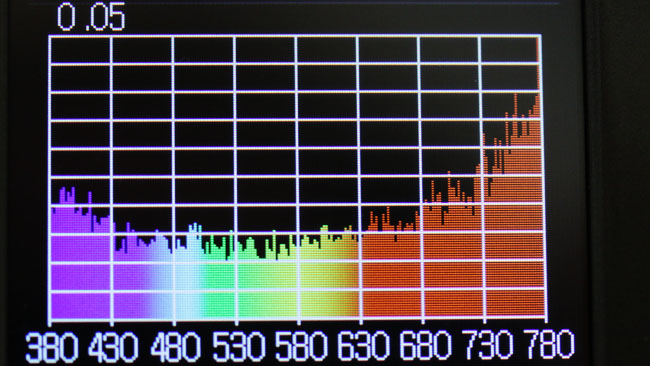
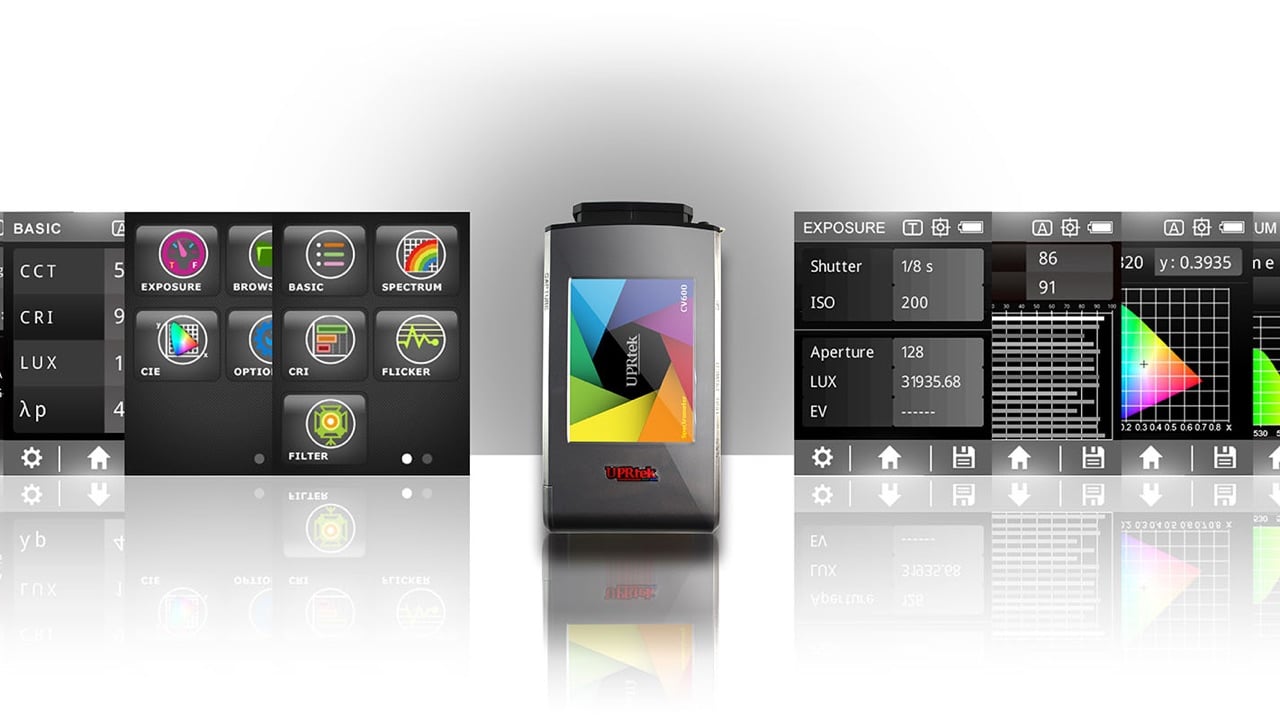 The best tool you never knew you needed
The best tool you never knew you needed
RedShark Review: A good colour meter can be a valuable addition to the toolbox. Some might say that they are essential. Phil Rhodes takes a detailed look at the incredibly capable UPRtek CV600 colour meter.
There was a time when lights were either tungsten or daylight. It's still like that now, or at least that's what you'd believe if you accepted every piece of literature from a lighting manufacturer at face value. In fact, wander the floor of a trade show for a few minutes and it becomes clear that there's a daylight for every day of the week and just as many slightly variable tungsten options to go with them. Even that's assuming that all the lights are of a good colour quality, to begin with. OK, we can point a camera at them on the day and spend time messing about with very fine grades of colour correction filters, but that's not very helpful if the light source in question is a practical in the ceiling of a huge warehouse or some other circumstance that would require a huge pre-rig.
Enter the colour meter
We've looked at colour meters before, but UPRtek's recently released CV600 adds a few features that have mainly been seen in unwieldy, expensive devices that are either designed to sit in a lab or that require an accompanying cell phone. The CV600 is a fully integrated handheld unit in the style of so many modern devices — a box with a touchscreen on the front. At £1400 it's not exactly cheap, but it's cheaper than the lab grade options and as we'll see, it has at least a few features that some of its most common competitors lack.
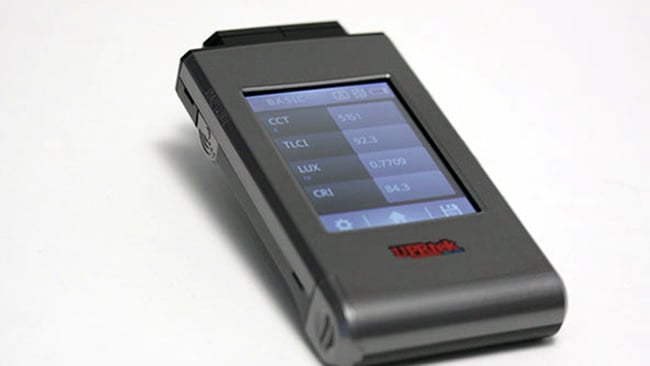
The UPRTek CV600 colour meter
The CV600 looks like a lot of modern tech: it's a small, easily pocket-sized device with a screen on the front, a sensor aperture at the top and a sample button on the side. It doesn't take AA cells as some others do, instead relying on an NP-100 camera battery as used in various products. These are available and affordable and the CV600 will charge its battery from USB power. The display is a fairly low-resolution resistive touchscreen which feels both fuzzy and unresponsive compared to the high-res capacitive displays on a modern cell phone. This is a common choice on a lot of devices such as this, which will sell in smaller quantities than a typical cell phone and it's possible that the manufacturers are hedging their bets against the availability of display components built for the phone market. Still, it's not as bad as some resistive touchscreens and it works well enough.
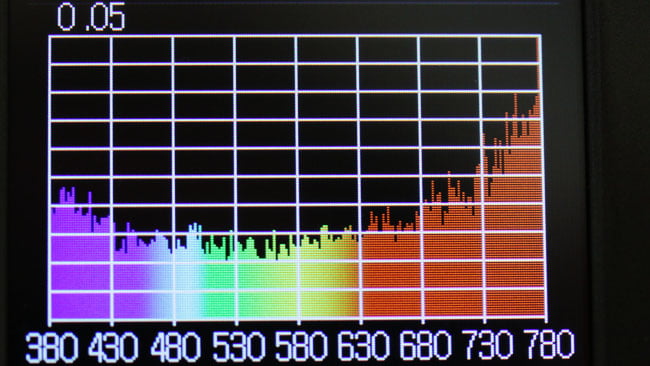
Spectral power distribution
The fundamental purpose of a device such as the CV600 is to measure the spectral power distribution of a light source and to perform calculations on the data to create useful estimates of colour quality such as CRI and (the more sensitive) TLCI. Basic features are as expected — the meter will produce a graph of spectral power distribution, which is one way of visualising a light's output the most complete possible and can serve as an indication of what problems to expect. A bar chart of exposures over the CRI test colour set is also given, though there is no equivalent for the Macbeth chart colours as they relate to TLCI. The TLCI is simply given as a number, though its presence is extremely welcome.
There are a number of other features intended to help out with the selection of colour correction filters. The CV600 knows how to recommend camera filters from both the Kodak Wratten and Fujifilm ranges, as well as Lee and Rosco lighting filters. The colour filter display is perhaps a little cryptic, expressing a Lee no. 204 Full C.T. Orange filter as “LBf 204, 1x,” but it'll be sufficiently clear to people who have the most common colour temperature correction filter numbers in long-term memory.
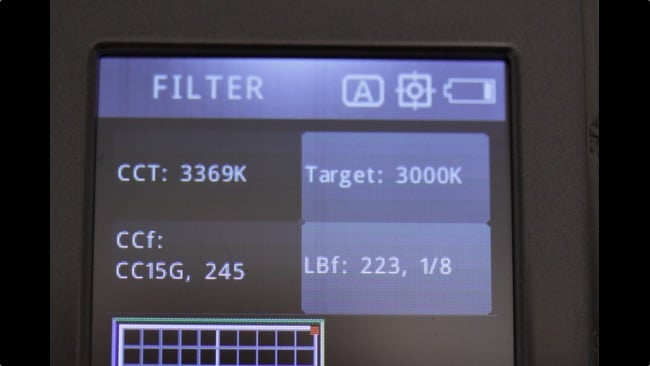
Filter calculations. Here the CV600 recommends a very small correction to move this tungsten-balanced LED closer to an ideal 3000K source
The filter calculation feature goes so far as to recommend corrections in the green-magenta axis too, which is no bad thing. It's this axis in which HMIs tend to drift apart from each other as they age. On one example read, the meter recommended a CC075G, equivalent to a Lee 246 one-quarter plus green, to match real-world daylight to a notional ideal 3000K blackbody. This is the sort of thing one might use to ensure practicals and lighting from more than one rental company might match and to order colour correction filters accordingly.
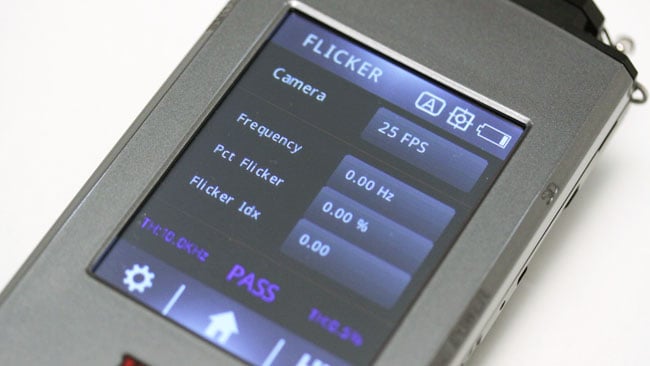
One valuable extra feature is flicker detection, which applies to both movie lights and practicals alike
As with any portable, handheld, reasonably-affordable, battery-powered colour meter, the CV600 presumably uses a series of light sensors behind carefully-controlled filters, plus some mathematics, to evaluate the light source under test. The very best laboratory spectroradiometers use a prism to split the incoming light into its constituent parts, then direct the resulting spectrum of colour through a narrow slit behind which is a very sensitive light detector. By rotating the prism, the energy level can be measured across the whole spectrum with enormous precision. That approach, while excellent, is not really feasible for a pocket colour meter and nothing the size of the CV600 has any practical option to do it that way. It's hard to objectively assess the CV600's accuracy without access to just the sort of lab-grade equipment we've just described, but it might be fair to assume that the CV600 is most accurate on lights which are at least attempting to be white. Still, it does at least a plausibly good job of assessing light sources such as the RGB backlight in a modern computer monitor, which is a hugely discontinuous spectrum.
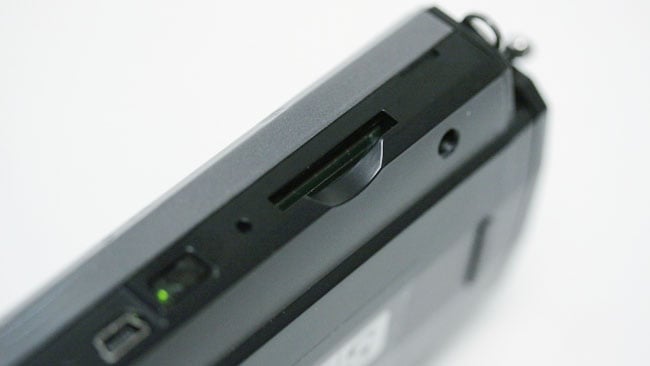
The CV600 allows data to be saved to an SD card, including both JPEG images and spreadsheets of mathematical data
Conclusions
Overall, the CV600 is one of the best currently available, fully integrated pocket colour meters. It has the ability to save test data in numeric format to an SD-card and it will perform TLCI calculations, which is something that at least one prominent competitor won't do. It actually has a conventional exposure meter feature too, although it doesn't support cinema-oriented exposure times between 1/30 and 1/60 second. The display tech is a letdown, albeit a fairly common one. Given the fact that lighting technology seems set to only get more complicated, this sort of thing is only going to become more necessary.
Tags: Production


Comments